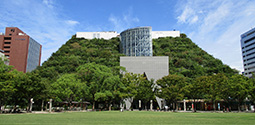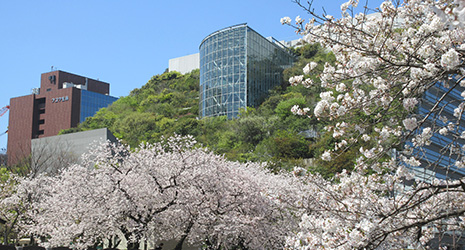
ACROS Fukuoka following its completion in 1995. The stepped pathway is visible to the left and right of the central glass atrium. 
ACROS Fukuoka in 2018
July 2021
Building a “Forest” in the Middle of the City

With a population of about 1.62 million (as of June 2021), Fukuoka City in Fukuoka Prefecture is one of Japan’s biggest cities. And in Fukuoka’s Tenjin downtown area there is a facility for residents to rest and relax; a building constructed some twenty-five years ago with the concept of gradual transformation into a mountain.

A small green “mountain” rises up unexpectedly in the heart of the city. ACROS Fukuoka, which local residents affectionately dub “ACROS Mountain,” is a multi-purpose commercial complex in the Tenjin area of Fukuoka City, Fukuoka Prefecture, the island of Kyushu’s premier downtown area. A multi-purpose commercial complex can be used for many things, but this one was built with the concept of “becoming a mountain in sixty years,” and has drawn interest since its construction. ACROS Fukuoka’s north-facing facade is a glazed building, but the south side adjacent to Tenjin Central Park is distinguished by the “Step Garden,” a tree-lined terrace. When the complex opened, 37,000 trees of seventy-six varieties had been planted, creating the impression of a dense mountain forest.
ACROS Fukuoka is 60 meters high with a green path of about 400 steps to the “summit” on which visitors can enjoy “mountain climbing.” The rooftop observation deck, designed to resemble a mountain summit, is open on weekends and holidays, affording visitors expansive views over Fukuoka City and Hakata Bay.
Kawano Atsuko, a representative of the company that manages the complex, says, “You can enjoy a pleasant view over Fukuoka City from the observation deck, but the restrictions on building height in the area have been eased and rebuilding work is now underway all over the place, so much so that this area is being called the ‘Tenjin Big Bang.’ No doubt we’ll see a different view from the observation deck after a few years.”
When trees grow, birds come to visit more frequently as well. More than twenty-five years have passed since construction was completed in 1995, and birds and bugs have brought seeds of flowers and trees so that the number of types of trees and plants has increased to about 200, more than twice the number at the beginning. A variety of birds can be seen throughout the year, such as brown-eared bulbuls in spring, blue-and-white flycatchers in summer, Daurian redstarts in fall, and pale thrushes in winter.

Kawano explains, “The plan is to return the trees to a mountain in the Kyushu countryside when the building’s service life of sixty years has passed and it can’t be used anymore. We weren’t anticipating this when the building was constructed, so there were also trees planted that are not normally found in Kyushu, but in recent years we’ve been replanting to get back to rearing as many types native to Kyushu as possible. We’re also gradually increasing the number of trees with leaves that change color in autumn so that everyone can enjoy different seasonal views.”
The weight of the soil is generally considered to be the main issue when planting greenery on a building. ACROS Fukuoka utilizes “aqua soil,” an artificial soil that is one-third the weight of normal soil. The soil is about 50 centimeters deep including a layer of natural perlite that is also lightweight and effective at both retaining and draining water. The soil prevents trees from falling over since the roots spread like capillaries and also reduces the risk of building damage since the growth of the roots stops at a certain point. Furthermore, this construction method of using artificial soil generates fertile soil as the trees’ leaves fall and are mixed in, so that in some cases there has been no need to replace or add soil in sixty years.

Moreover, rainwater not absorbed by the trees is stored in tanks then used in sprinklers and toilets. The trees also provide leafy shade which helps to alleviate the heat island phenomenon. An investigation of ACROS Fukuoka by nearby Kyushu University found that at night following sunny days air cooled by radiative cooling formed a cool breeze, flowed to the adjacent park and yielded lower temperatures than surrounding urban areas.
Even if development continues in the area and the view from ACROS Fukuoka changes, the value of this mountain that rises up in the downtown area of a large city will not change, while it celebrates greenery as a “forest” and continues to provide visitors with tranquility and rest.

